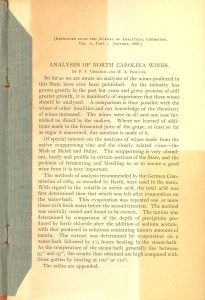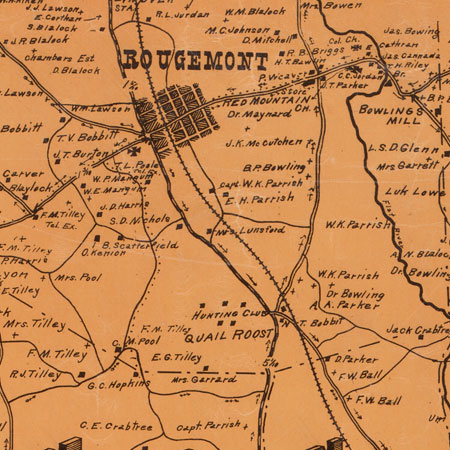The only true “analyses” of North Carolina wines I’ve ever done is the drinking kind. Titration tubes, Erlenmeyer flasks, and specific gravity sort of scare me–or at least the grades I got in my college chemistry labs scared me. So, I think I’ll just stick to the tasting of NC’s vino. However, I found the following analyses of NC wines by F. P. Venable (former president of UNC) and W. B. Phillips (a former professor at UNC) while looking for something else. It dates from 1888, so I don’t think that any of the state’s current crop of vintners is represented, but there is a discussion of the scuppernong “and the closely related vines–the Mish or Meish and Bulay.” Pop the cork and enjoy…
Month: June 2011
Sunday link dump offers trio of twofers
— At last, Revenge is ours (or not). Including Blackbeard’s artisanal arsenal.
— eBay eye-catchers: a medal of Lost Cause honor and a poster for Louis Armstrong at Carmichael Auditorium.
— What exactly is a Confederate monument? And what should Reidsville do with the one that lost its kepied head to a reckless driver?
Making laws, breaking laws, faking laws
The dust-up over state Sen. Don East’s 145-mph joyride brings to mind previous legislative wheelmen and their real or imagined immunities.
In 1992 state Sen. Joe Johnson of Wake County, pulled over by Raleigh police for not wearing a seat belt as he drove to a lobbyists’ reception, cited a 1787 law protecting legislators “except in cases of crime, from all arrest and imprisonment during the time of their going to, coming from, or attending the General Assembly.”
Johnson persuaded the district attorney to drop the citation, but two weeks later he gave in to public protest by paying the $25 fine and apologizing for having demanded that two police officers be fired. The legislature, embarrassed, rewrote the law to clarify that it doesn’t extend to infractions such as seat belt violations and expired inspection stickers.
And then there’s this intriguing brief from Time magazine (Jan. 21, 1952): “After a 17-mile race through a mounting North Carolina blizzard, Mississippi’s Democratic Representative John E. Rankin was arrested by a highway patrolman, charged with careless and reckless driving. Ol’ John’s futile defense: congressional immunity to arrest except for ‘treason, felony, or a breach of the peace.’ “
Part slave, part free — and completely entangled
“The legal complications encountered by families part slave and part free were nothing short of Byzantine, and in many cases Solomon himself would have been hard pressed to mete out justice.
“A slave named Miles took a slave wife in North Carolina. He was freed by his master and then purchased his wife, whom he in turn freed. One of their children was born when the mother was a slave, the others when she was free. When the mother died, Miles remarried a free woman of color by whom he had several more children.
“In 1857 Miles died intestate; the children of both mothers disputed the division of property. The North Carolina Supreme Court reasoned that the children of the first marriage had no claim to the estate since slaves could not make contracts that were legally binding. Thus Miles’s original marriage was a ‘fiction,’ the children not recognized as legal heirs. He had, in short, failed to legitimize the marriage once he and his wife had become free.”
— From “Selling Poor Steven” by Philip Burnham (American Heritage magazine, Feb/March 1993)
Rougemont, Inc.–One Step Closer
Rougemont residents hoping to create Durham County’s second town got some good news yesterday. The state’s Senate Finance Committee approved the bill and sent it on to the full Senate for a vote. The N.C. House has already approved the measure and a yay from the Senate would pave the way for residents to vote on incorporation in November.
With the help of State Rep. Winkie Wilkins, residents of the northwest Durham County community have submitted legislation on incorporation in each session of the General Assembly since 2005. Their efforts have been opposed by several Durham County legislators, who fear that the creation of a second municipality in the county could complicate future merger of services between the city of Durham and the county.
According to The North Carolina Gazetteer, Rougemont takes its name from the French words for nearby 561-foot Red Mountain–rouge mont. An 1881 map of Durham County shows a Red Mountain Post Office, so when did locals start referring to their community in French? Was there a wave of French immigration to Durham County? Or was someone putting on airs? We’ll try to find out. Meanwhile, we’ve got some questions for you. What other N.C. communities have names constructed from foreign words? And what other North Carolina counties have only one or no incorporated communities? We eagerly await your replies.
Give us your tired, your poor… your whacked out?
“By 1785, some influential Methodists in the Chesapeake had concluded that [Rev. William Glendinning, overwrought and perhaps suicidal] needed either to be treated by doctors or, that failing, quarantined from the faithful.
“So they tied him up and spirited him across the border to North Carolina, a place in the South then akin to what Rhode Island had been earlier in New England — a remote exile for those whose religious eccentricities embarrassed more sober Christians.”
–– From “Southern Cross: The Beginnings of the Bible Belt” by Christine Leigh Heyrman (1997)
North Carolina State Historic Preservation Office GIS Map
Want to see what historic properties are located near you? Check out this very cool map produced by the State of North Carolina’s State Historic Preservation Office:
You can zoom to street level detail to see if there is anything near you. I did it for my parents’ house in Davie County–and found out that a seemingly dilapidated house on their road has actually been identified as a historic structure.
For more information on the map, see the following article from Directions Magazine:
State Historic Preservation Office launches Web site with virtual view of historic landmarks
A most untraditional Confederate ‘colonel’
“Through the agency of a white lawyer, the Petteys purchased a resort in rural Alexander County, North Carolina, across the mountain from the Wilkes County homeplace where Charles Pettey had been born in slavery in 1849…. The Petteys now owned All Healing Spring, a premier ‘Health Resort and Pleasure Retreat’…. The resort’s patrons had always been and would remain white — always….
“The surrounding community discovered that the Petteys were the new owners in short order. A local white woman dutifully recorded each of the spring’s proprietors in her scrap book from 1892 until 1912. Next to Charles Pettey’s name, she wrote ‘Col.’
“What was clear to contemporaries became shrouded in legend in subsequent years, and local folklore transformed Pettey from an African American into a white Confederate colonel.”
— From “Gender and Jim Crow: Women and the Politics of White Supremacy in North Carolina, 1896-1920″ by Glenda Elizabeth Gilmore (1996)
Big hit for Andy, big loss for record industry?
“For the jukebox and disk-jockey trade, record companies are reviving an old idea: ‘talk’ records. These are comedy sketches or monologues of the type that helped kill vaudeville and weakened radio to the point where television became inevitable. Last week one of them, ‘What It Was, Was Football,’ was striking for the bestselling list.
” ‘Football,’ the creation of a 27-year-old North Carolina singer and former teacher named Andy Griffith, is a monologue purporting to be a wandering hillbilly’s wide-eyed reactions to his first sight of a crowded college stadium, and is notable chiefly for Griffith’s relentless rural drawl. Sample:
” ‘What Ah seen was this whole raft o’ people a-settin’ on these two banks and a-lookin’ at one another across this pretty little green cow pasture’….
“Griffith has moved to Manhattan, is planning to investigate subways, automats, tipping, etc. Backing him up is Capitol Records, which… will pay him a weekly salary (‘over $100’) instead of the usual percentage of sales, will also manage his career. Probably nothing can be done about it.”
— From Time magazine, Jan. 18, 1954
They say it’s spinach, and they say to hell with it
“Investigating their state’s notoriety as a ‘stone area,’ two University of North Carolina doctors reported that too much spinach is a major cause of kidney stones.
“The stones are caused by excess oxalic acid in the diet, said researchers James C. Andrews and Claude L. Yarbro, and the ‘much-praised spinach is one of the worst offenders.’ “
— From Time magazine, April 9, 1956
Andrews and Yarbro were onto something, if not quite as much as they thought. More recent research has turned to the South’s taste for high-fat foods and its hot weather, a contributor to dehydration.



